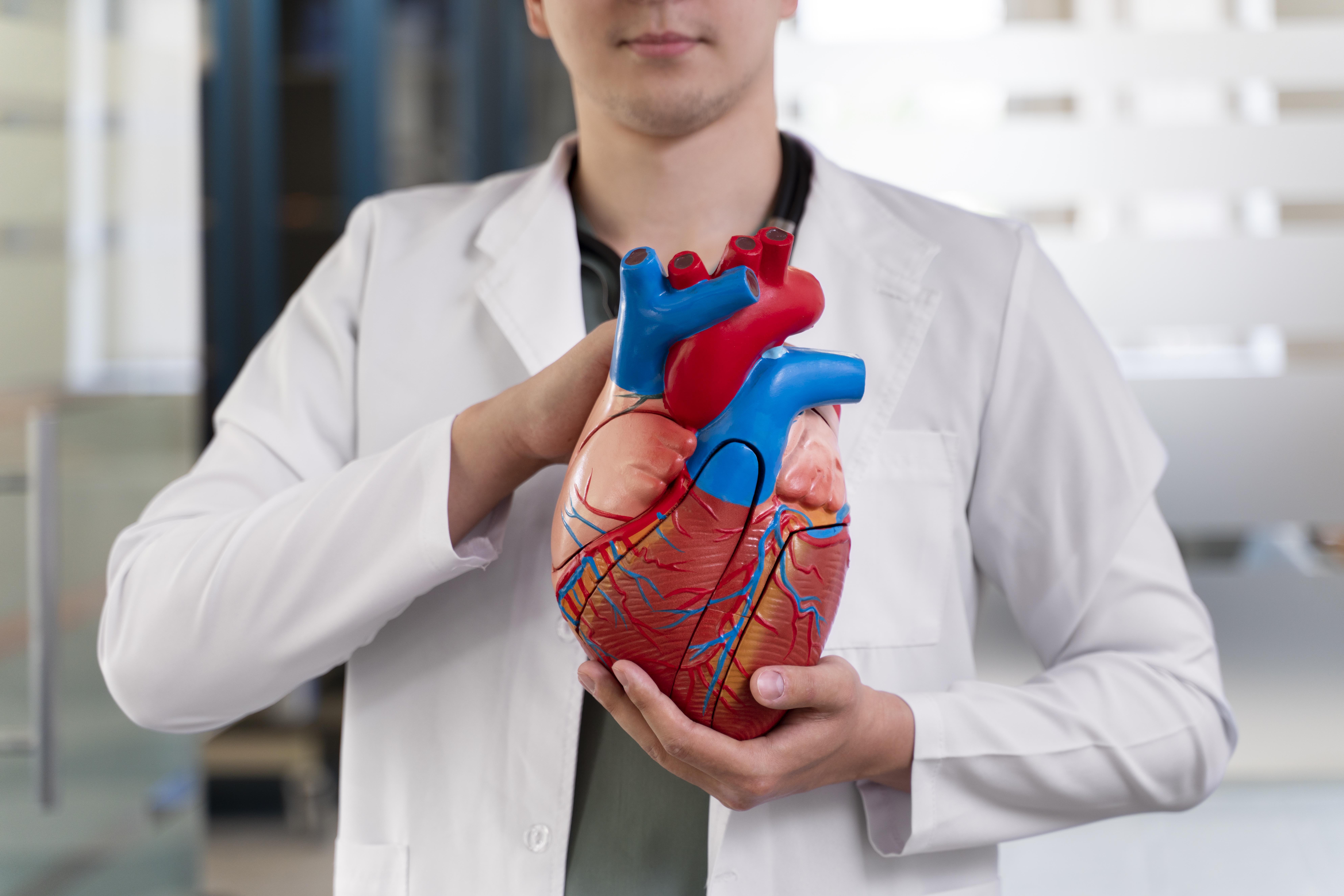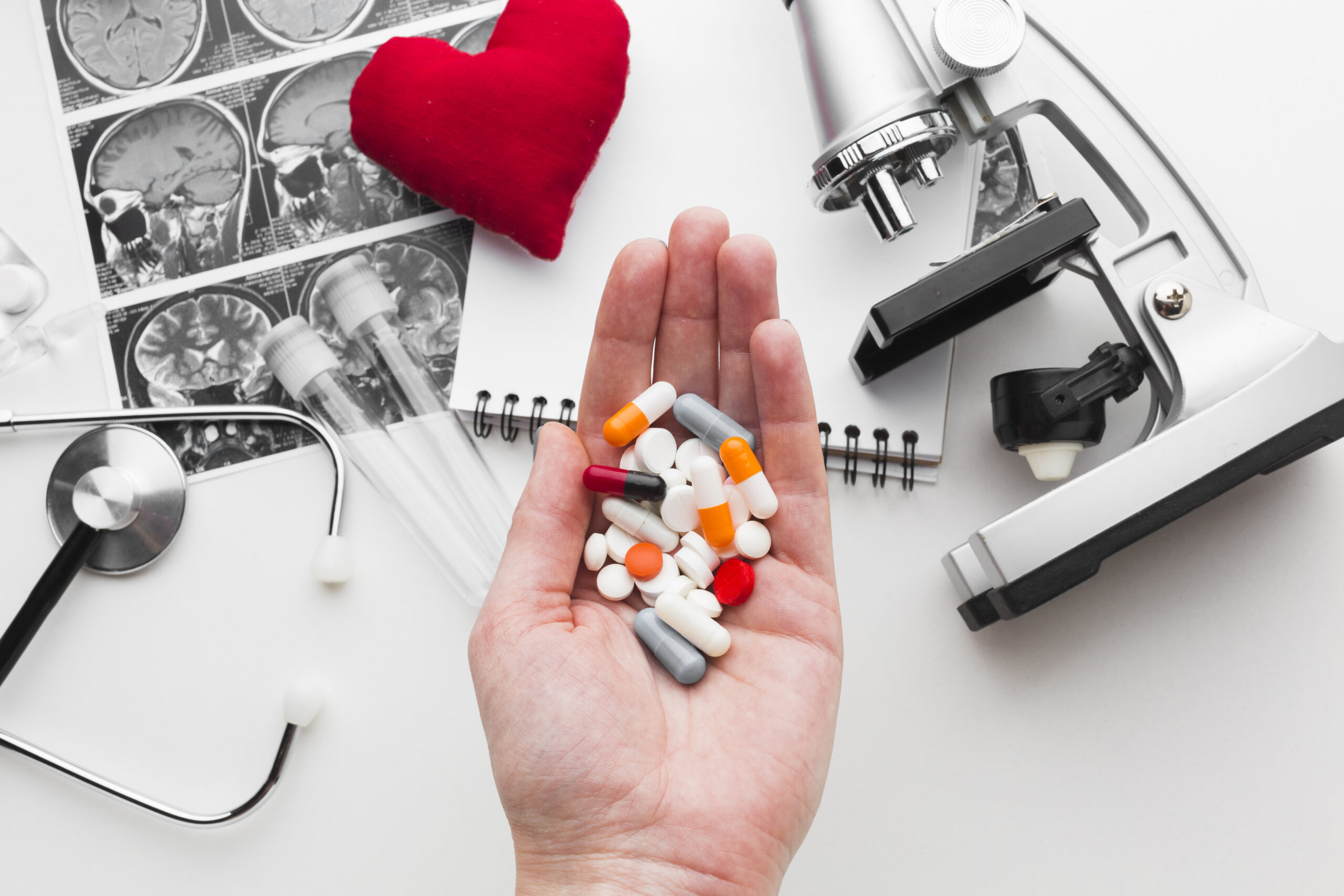Arrhythmia is a disturbance of the heart rhythm. If the heart rhythm is too slow, the arrhythmia is called bradyarrhythmia; if it is too fast, it is called tachyarrhythmia.
In cardiac arrhythmias, the heartbeat may be regular (it differs from the normal rhythm only in frequency) or irregular, with premature heart contractions or with the absence (dropping out) of expected heart contractions.
A healthy, properly functioning heart is stimulated to contract by natural electrical impulses, which are conducted by a specialized system of cells called the cardiac conduction system. This system can best be compared to an electrical installation that delivers stimuli to the right place at the right time. Thanks to it, the heart chambers are stimulated to contract in a strictly organized, sequential manner (first the atria and soon after the ventricles), which ensures the most effective blood flow through the heart.
The functioning of the cardiac conduction system is influenced by many systemic and local factors, which allow the speed and regularity of the heart rhythm to be adjusted to the body's current needs. Therefore, the heart works slower at rest and much faster during exercise or nervousness. That is why the heart of a person suffering from a fever works much faster. Systems controlling the conduction system also cause the heart to beat slightly faster during inspiration than during exhalation.
The stimuli that stimulate the heart to contract and are conducted through the conduction system arise in the group of cells that constitute its highest point, located in the right atrium and called the sinus node. From here, impulses are conducted to all parts of the heart. The sinus node is the heart's natural pacemaker, and its work gives the heart a regular rhythm.
This condition may occur transiently or be permanent. Many factors can cause them, but many of them have an unknown cause. They may be congenital, in which case the baby is born with an abnormal heart rhythm. They also accompany some heart defects.

Cardiac arrhythmias![]() can be divided into two groups. The first group includes disorders related to increased heart rate, i.e., tachyarrhythmias
can be divided into two groups. The first group includes disorders related to increased heart rate, i.e., tachyarrhythmias![]() . The second group is dysrhythmias related to a slow heart rate – bradyarrhythmias
. The second group is dysrhythmias related to a slow heart rate – bradyarrhythmias![]() .
.
Some specialists focus more on two types of cardiac arrhythmia: supraventricular![]() (including atrial flutter, atrial fibrillation, atrial, nodal, atrioventricular tachycardia, and sinus tachyarrhythmias) and ventricular
(including atrial flutter, atrial fibrillation, atrial, nodal, atrioventricular tachycardia, and sinus tachyarrhythmias) and ventricular![]() (including ventricular tachycardia, ventricular fibrillation, and additional ventricular beats).
(including ventricular tachycardia, ventricular fibrillation, and additional ventricular beats).
Ventricular arrhythmia arises below the atrioventricular node. These disorders include monomorphic and polymorphic ventricular tachycardia, accelerated idioventricular rhythm, premature ventricular beats, and the most dangerous one – ventricular fibrillation![]() . Ventricular fibrillation is one of the rhythms that cause cardiac arrest – myocytes contract in complete chaos independently of each other, which translates into a lack of adequate contractile force of the heart
. Ventricular fibrillation is one of the rhythms that cause cardiac arrest – myocytes contract in complete chaos independently of each other, which translates into a lack of adequate contractile force of the heart![]() . The situation is similar in the case of ventricular tachycardia in a hemodynamically incompetent patient – blood circulation then ceases.
. The situation is similar in the case of ventricular tachycardia in a hemodynamically incompetent patient – blood circulation then ceases.
Supraventricular arrhythmia is characterized by the impulse arising above or in the atrioventricular node. These include bradycardia![]() (heart rate less than 60 beats/min), tachycardia
(heart rate less than 60 beats/min), tachycardia![]() more than 100 beats/min), sick sinus syndrome, atrial fibrillation and flutter, premature atrial beats, atrial tachycardia, and atrioventricular node tachycardia.
more than 100 beats/min), sick sinus syndrome, atrial fibrillation and flutter, premature atrial beats, atrial tachycardia, and atrioventricular node tachycardia.
The causes of cardiac arrhythmia![]() are different for tachycardia and bradycardia. We may be dealing with physiological tachycardia during exercise or stress. Acceleration of the heart rate may also result from other causes. It is often the result of taking various types of substances: caffeine, nicotine, but also drugs. The meta-analyses show that there is a strong relationship between chronic alcohol
are different for tachycardia and bradycardia. We may be dealing with physiological tachycardia during exercise or stress. Acceleration of the heart rate may also result from other causes. It is often the result of taking various types of substances: caffeine, nicotine, but also drugs. The meta-analyses show that there is a strong relationship between chronic alcohol![]() abuse and the incidence of atrial fibrillation. The risk of atrial fibrillation increases linearly with the daily dose of alcohol consumed.
abuse and the incidence of atrial fibrillation. The risk of atrial fibrillation increases linearly with the daily dose of alcohol consumed.
This condition can arise from fever, dehydration, anemia, hyperthyroidism, or hypoglycemia. More severe causes of elevated heart rate include anaphylactic reactions, heart failure, and even myocardial infarction. Conversely, bradycardia may be linked to hypothyroidism, ischemic disease, or elevated potassium levels in the body.
Certain medical disorders can increase the risk of cardiac arrhythmia![]() . It includes:
. It includes:
Moreover, some prescription medications, common over-the-counter coughs, and common cold medications can cause this condition. Drinking a lot of alcohol can influence the electrical impulses in the heart and raise the gamble of atrial fibrillation.
To sum up, the specialists divide causes of atrial fibrillation into cardiac and non-cardiac. Cardiac causes include hypertension, acquired valvular defects, ischemic heart disease, congenital heart defects, myocarditis and pericarditis, previous heart surgery, sick sinus syndrome, pre-excitation syndrome, systemic diseases involving the heart, and primary and metastatic heart tumors.
Non-cardiac causes include hyperthyroidism, acute infection, general anesthesia, lung diseases, pheochromocytoma, obesity, diabetes, chronic kidney disease, and various substances, including stimulants (alcohol, caffeine, carbon monoxide, and some drugs).
Cardiac arrhythmias can be asymptomatic and may be incidentally discovered during a routine examination. However, common arrhythmia symptoms![]() include palpitations, fluttering sensations in the chest, tachycardia, chest pain, and dyspnea.
include palpitations, fluttering sensations in the chest, tachycardia, chest pain, and dyspnea.
Patients may also experience anxiety, fatigue, dizziness, blurred vision, excessive sweating, and episodes of fainting or near-fainting (presyncope).

ECG is mainly used to diagnose![]() heart rhythm disorders. Sometimes arrhythmia can be detected already during a resting ECG examination, but most disorders are paroxysmal and last for a short time. Therefore, a twenty-four-hour Holter ECG recording is used to detect them.
heart rhythm disorders. Sometimes arrhythmia can be detected already during a resting ECG examination, but most disorders are paroxysmal and last for a short time. Therefore, a twenty-four-hour Holter ECG recording is used to detect them.
Additionally, echocardiography (ECHO heart test) is performed to assess whether the arrhythmia is caused by a heart defect, heart failure, or other abnormalities that can be detected during an ultrasound examination.
Treatment of cardiac arrhythmia![]() involves the use of medications or surgical procedures that cause an inadequate heart rate or irregular rhythms. If left untreated, arrhythmias can cause damage to the heart muscle, brain, or other organs. The complications may lead to life-threatening stroke, heart failure, or even cardiac arrest.
involves the use of medications or surgical procedures that cause an inadequate heart rate or irregular rhythms. If left untreated, arrhythmias can cause damage to the heart muscle, brain, or other organs. The complications may lead to life-threatening stroke, heart failure, or even cardiac arrest.
In the pharmacotherapy of arrhythmia, antiarrhythmic drugs (antiarrhythmic drugs) are used, which aim to:
Classification of antiarrhythmic drugs, according to Vaughan-Williams![]() distinguished:
distinguished:

Electrical cardioversion![]() is mainly performed in patients with tachyarrhythmias, especially atrial fibrillation or flutter. The procedure is performed on a planned basis when, for example, atrial fibrillation does not respond to pharmacological treatment. Urgent cardioversion is performed when it is necessary to treat very rapid arrhythmias that cause life-threatening circulatory disorders. The procedure is performed using a defibrillator with cardioversion function under short-term general anesthesia. The doctor places two of the device's electrodes in appropriate places on the patient's chest, and the electrical impulse released from the defibrillator normalizes the heart rhythm. Cardioversion is a safe procedure, and patients are usually discharged from the hospital within a few hours after the procedure.
is mainly performed in patients with tachyarrhythmias, especially atrial fibrillation or flutter. The procedure is performed on a planned basis when, for example, atrial fibrillation does not respond to pharmacological treatment. Urgent cardioversion is performed when it is necessary to treat very rapid arrhythmias that cause life-threatening circulatory disorders. The procedure is performed using a defibrillator with cardioversion function under short-term general anesthesia. The doctor places two of the device's electrodes in appropriate places on the patient's chest, and the electrical impulse released from the defibrillator normalizes the heart rhythm. Cardioversion is a safe procedure, and patients are usually discharged from the hospital within a few hours after the procedure.
In the case of severe bradycardia, i.e., a plodding heart rhythm associated with the symptoms reported by the patient (e.g., fainting, dizziness, increased fatigue, or decreased exercise tolerance) or longer pauses in the heart's activity, it may be necessary to implant a pacemaker. This device will stimulate the heart when the heart rate is too slow.
A cardioverter-defibrillator![]() is a device that can recognize episodes of both tachyarrhythmia and bradyarrhythmia, as well as generate electrical discharges (impulses) that lead to the restoration of normal heart rhythm. Implantation of a cardioverter-defibrillator is particularly recommended in patients with heart failure who also suffer from arrhythmias. This is often the only solution for people at risk of sudden cardiac death.
is a device that can recognize episodes of both tachyarrhythmia and bradyarrhythmia, as well as generate electrical discharges (impulses) that lead to the restoration of normal heart rhythm. Implantation of a cardioverter-defibrillator is particularly recommended in patients with heart failure who also suffer from arrhythmias. This is often the only solution for people at risk of sudden cardiac death.
Percutaneous ablation![]() aims to destroy the area within the heart muscle that generates stimuli causing arrhythmia using radio waves or freezing. The heart is reached via a catheter inserted into a vein or femoral artery. Percutaneous ablation is performed mainly in patients with atrial fibrillation refractory to antiarrhythmic therapy. Patients who take anticoagulants should discontinue them before the procedure for a period specified by the doctor. Antiarrhythmic drugs should be discontinued as directed by the physician. Surgical ablation is a more invasive procedure requiring chest opening, so it is performed less frequently.
aims to destroy the area within the heart muscle that generates stimuli causing arrhythmia using radio waves or freezing. The heart is reached via a catheter inserted into a vein or femoral artery. Percutaneous ablation is performed mainly in patients with atrial fibrillation refractory to antiarrhythmic therapy. Patients who take anticoagulants should discontinue them before the procedure for a period specified by the doctor. Antiarrhythmic drugs should be discontinued as directed by the physician. Surgical ablation is a more invasive procedure requiring chest opening, so it is performed less frequently.
In general, complications of cardiac arrhythmia![]() can include stroke, development of heart failure, and sudden cardiac arrest.
can include stroke, development of heart failure, and sudden cardiac arrest.
Heart rhythm disruptions are associated with an increased risk of blood clots developing in the vessels or chambers of the heart (most often in a place called the left atrial appendage). If the clot breaks off, it can transit from the heart to the brain, causing an ischemic stroke. Blood thinners (anticoagulants) lower the chance of stroke associated with atrial fibrillation and other arrhythmias.
During a visit to a doctor after detecting a cardiac arrhythmia, the doctor determines whether and which anticoagulant drug the patient will take. Please remember that when taking some anticoagulants, it is necessary to regularly monitor some blood coagulation parameters by performing laboratory tests
The doctor determines how often and whether it is essential to observe these matters during the arrhythmia treatment with anticoagulation.